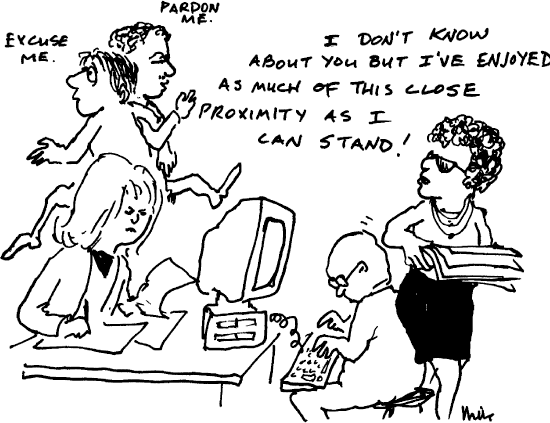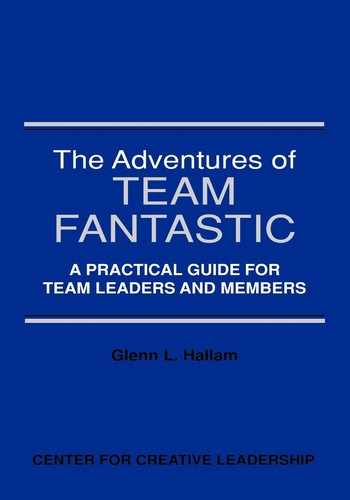Building Commitment
Fortunately, you have not been completely abandoned in the jungle. As the drums beat louder and draw closer, you hear a helicopter flying overhead and see a small package crashing through the trees to the ground. The package contains instructions to walk north to the river, where the team will find a raft. The message warns, “Paddle quickly to avoid hidden dangers.”
Team Fantastic is now seated together in the raft, paddling down the river. Although most of you are paddling furiously, two members in the back of the boat have fallen asleep. Without full power, the raft has slowed, becoming vulnerable to hidden dangers: alligators that have entered the water and are now converging on the boat. “Wake up! Wake up! Let’s get moving!”
Why would these two members fall asleep while others work so hard? Perhaps they are unaware of the alligators. Perhaps they don’t care about finding the diamonds. Perhaps they are simply too tired and undernourished to continue paddling. Perhaps they are too comfortable as they drift on a beautiful river in the sun. Perhaps they are in poor physical condition and therefore not capable of helping the team at this moment. Perhaps they are sick. Or perhaps they are trying to send the team a message.
On your real-life team, as on Team Fantastic, a number of factors have to go right for members to be committed. Members need to be psychologically and physically well-nourished, interested in the goals of your team, and aware of the consequences of failure. They need to be capable of expending time and energy for the betterment of your team and not distracted by issues such as personal problems or team conflict.
Member commitment also depends on (and is reflected by) your team’s norms: unwritten but powerful rules of acceptable behavior. On your real team are members expected—either implicitly or explicitly—to work late to meet deadlines? Help each other in stressful times? Come to meetings on time? Are they expected to put team interests before their own?
Norms develop soon after a team is formed and are quickly conveyed to new members. Changing them can be difficult, which is why it is important that productive norms be established early in a team’s formation. In the beginning of the river journey, if someone on Team Fantastic had said, “Whatever we do, let’s not stop paddling—there are hidden dangers out there,” the two slumbering passengers may have remained alert.
Ways the Leader or Prominent Member Can Help
Write down what you believe to be the unwritten rules that guide the actions of your team. Here are some examples:
“We do whatever it takes to be the best.”
“Members wait for the leader to take initiative, then follow.”
“When the pressure is on, everyone gives 110%.”
“We work hard enough to meet the minimum requirements, no harder.”
Identify which rules seem beneficial and which ones are obstacles.
Explicitly set new team norms. Discuss as a team how you want to behave together. (This exercise will apply to many aspects of teamwork, not just commitment.) Embrace the positive norms of the past. Set new norms to replace unhelpful ones.
Live the new team norms. Make it obvious that you are honoring your commitment to these norms. Your example—whether it reflects deep concern for the team or complete apathy—will be noticed by your teammates.
Assign well-defined tasks to specific individuals and hold them accountable. This will help to counteract a phenomenon called social loafing: In large teams members sometimes slow down, knowing that they can rely on star performers to carry the team to success. If the members of Team Fantastic who stopped paddling were in their own rafts and solely responsible for their fate, they might have paddled their hearts out.
Grant members more control over their work. If you have confidence in them, allow members to take personal initiative and exercise discretion. (See chapter 11—“Empowering Yourself and Teammates.”)
Give members the opportunity to perform a number of different activities to broaden their skills and perspectives. Members will come to enjoy work that is varied and challenging.
Allow members to produce a whole and visible piece of work. Members are more likely to enjoy their work and become personally invested in it if they can look at the outcome of their work and say, “We did that.”
Introduce members to their constituents. Members tend to be more committed when they realize the significance of their work—for the organization, customer, or society as a whole. Such an appreciation can be gained by meeting and talking to the people who rely on the work of the team.
Minimize outside distractions. To use an example from athletics, if a star quarterback is failing classes, a competent coach will arrange for tutoring. Similarly, a good coach in the business setting will attend to the personal problems and distractions experienced by the members. For instance, encourage your teammates to utilize your company’s employee-assistance program to address personal problems and work with your teammates to avoid scheduling conflicts.
Keep your team small. In small groups (no more than fifteen and preferably fewer than ten), members generally receive more rewards and feedback, have more influence within the group, and are more accountable. The result is that members sometimes feel more committed to smaller teams.
Gather members together so they work in physical proximity, or at least provide ample opportunity for members to interact. Members can be energized by the encouragement (and pressure) they receive from each other. (This phenomenon is known as social facilitation.)

Ways All Members Can Help
Set a positive example of commitment. If you want to change the team, start with yourself. If you set a clear, conspicuous, and consistent example of commitment, other members will notice; some may follow.
See other topics in this book that relate to commitment. For example, set clear personal goals. (See chapter 10—“Clarifying Personal Goals.”) As a team, clarify and reinforce your mission. (See chapter 7—“Clarifying the Mission.”) Explore whether members are properly rewarded for their work. (See chapter 15—“Rewarding Performance.”)
